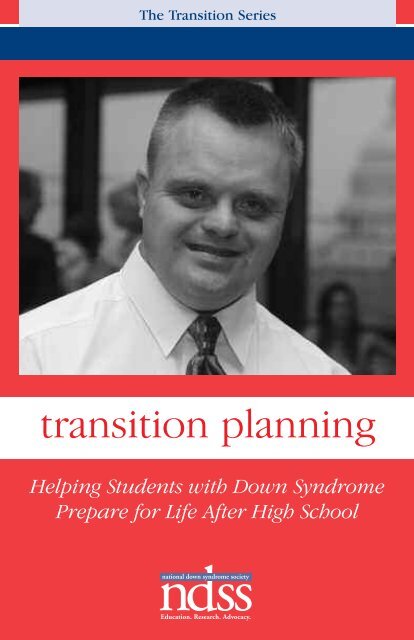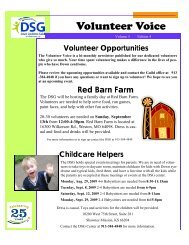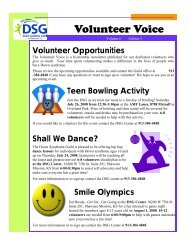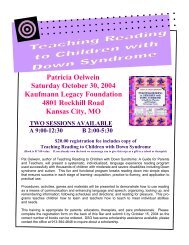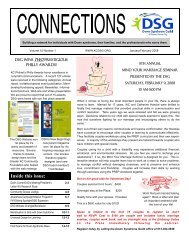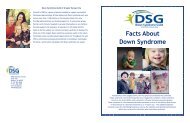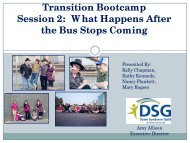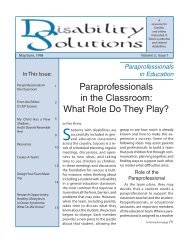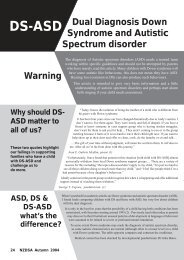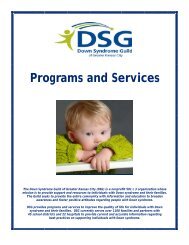Transition Planning for Students with Down Syndrome
Transition Planning for Students with Down Syndrome
Transition Planning for Students with Down Syndrome
- No tags were found...
You also want an ePaper? Increase the reach of your titles
YUMPU automatically turns print PDFs into web optimized ePapers that Google loves.
The <strong>Transition</strong> Seriestransition planningHelping <strong>Students</strong> <strong>with</strong> <strong>Down</strong> <strong>Syndrome</strong>Prepare <strong>for</strong> Life After High School
transition planningThis Brochure:• Provides an introduction to transition planning.• Presents various options available after high school.• Describes why, when and how transition planning should beinitiated.• Identifies the components of a successful transition plan.• Explains when and how to evaluate and modify the transitionplan.About the NDSS <strong>Transition</strong> Series:The National <strong>Down</strong> <strong>Syndrome</strong> Society (NDSS) has developed the<strong>Transition</strong> Series to help individuals <strong>with</strong> <strong>Down</strong> syndrome, parentsand professionals understand the options available after high school,and to provide answers to many of the important questions aboutthis next stage of life. While this series is most relevant to teenagersand young adults, it is never too early to begin thinking about andpreparing <strong>for</strong> this transition.The NDSS <strong>Transition</strong> Series will consist of four brochures:<strong>Transition</strong> <strong>Planning</strong>, an introduction to the transition planningprocess; Post-Secondary Education, an exploration of the variouseducational options available after high school; Employment, adiscussion about how to prepare <strong>for</strong> and find the right job; andHousing, a guide to selecting the most suitable living arrangement.Each brochure in the series will be supplemented by a regularlyupdatedresource list that provides additional details and assistanceon the topic.
National <strong>Down</strong> <strong>Syndrome</strong> Societytransition planningabout transitioningWe are all constantly transitioning throughout our lives. We go fromone grade to the next, from one job to another, or from living athome to living on our own. While all of us handle change in our ownway, major transitions often give rise to conflicting feelings. Forexample, we might look <strong>for</strong>ward to new experiences, yet worry aboutthe unknown. Taking adequate time to prepare and planning well arethe best ways to alleviate the stresses that can accompany transition.With that in mind, NDSS has developed this brochure to helpindividuals <strong>with</strong> <strong>Down</strong> syndrome and their families begin thinkingabout one of the most important transitions of all — the move fromhigh school to life after high school — and to encourage them tostart making plans as early as possible.2
National <strong>Down</strong> <strong>Syndrome</strong> Societytransition planningWhat will change after high school?While in school, most, if not all, of the resources that make up astudent's principal support system of special education and relatedservices are mandated by law. Upon graduation, the student will nolonger be eligible <strong>for</strong> many of the services, and the responsibility ofidentifying, locating and coordinating appropriate resources will fallmainly upon the individuals and their families.With proper planning, many important resource links can already bein place by the time the student graduates. There are many optionsavailable to individuals <strong>with</strong> <strong>Down</strong> syndrome after high school, butthe best way to ensure a successful transition is to start planning <strong>for</strong>it long be<strong>for</strong>e graduation.3“<strong>Transition</strong> planning can never start tooearly. Children <strong>with</strong> <strong>Down</strong> syndrome wantthe same things in life as their typicalsiblings, such as moving away from homeinto their own housing, finding a job, orgoing to school. This was the expectationof our two sons <strong>with</strong> disabilities. Westarted planning early to make thetransition as smooth and successful as itcould be <strong>for</strong> everyone involved. Due toearly planning, both boys are participatingmembers of their community and have anenriched quality of life.”– Michael Remus, Director of SpecialEducation, Portland, OR,Public SchoolsWhat does transitionplanning involve?<strong>Transition</strong> planninginvolves looking towardsthe future and envisioningall the skills andpreparations that will beneeded to lead the mostfulfilling life possible.Looked at in this way, alltraining and educationreceived during childhoodand adolescence are partof transition planning.However, <strong>for</strong>mal transitionplanning involves adocument called atransition plan, which isrequired by law to <strong>for</strong>mpart of a student'sIndividualized EducationPlan (IEP) starting at age14.
National <strong>Down</strong> <strong>Syndrome</strong> Societytransition planningInitially, the IEP can include general transition goals, but by age 16,the Individuals <strong>with</strong> Disabilities Education Act (IDEA) requiresthat the IEP contain a statement of “transition services,” orpost-secondary agency or services links, that the student needs inorder to transition successfully.<strong>Transition</strong> planning is, there<strong>for</strong>e, a right that exists <strong>for</strong> all students<strong>with</strong> disabilities. It is important that individuals <strong>with</strong> <strong>Down</strong>syndrome be as involved as possible in making decisions abouttheir future. <strong>Transition</strong> goals should reflect a student's interests,abilities and dreams, and the plan should outline specific objectivesto help him or her achieve those goals.What kinds of opportunitiesare available after highschool <strong>for</strong> individuals <strong>with</strong><strong>Down</strong> syndrome?There are many opportunities <strong>for</strong>individuals <strong>with</strong> cognitivedisabilities after graduation, but thethree areas most frequentlyconsidered are: post-secondaryeducation, employment andhousing. Today, there are moreopportunities than ever be<strong>for</strong>e <strong>for</strong>individuals <strong>with</strong> <strong>Down</strong> syndrome topursue goals in these areas.Successful transitioning willnot only depend on a goodunderstanding of the individual'spersonal strengths and interests,but also on knowledge of whatoptions and services are availablein the community.“The primary concern wasplanning <strong>for</strong> Kim's lifesituation, employment, andwhere she would ultimatelylive. We wanted there to be acontinuation of theprograms, stimulation andactivities that she hadenjoyed. Even thoughgraduation was still a fewyears away, we knew we hadto start thinking aboutthe process.”– Eglon Simons, Parent4
National <strong>Down</strong> <strong>Syndrome</strong> Societytransition planningPhotograph by Clara Link, courtesy of The <strong>Down</strong> <strong>Syndrome</strong> Community 2004 Calendar, Living it Up!www.downsyndromecommunity.org.post-secondary educationIndividuals <strong>with</strong> <strong>Down</strong> syndrome have the opportunity toparticipate in a variety of post-secondary education programs,such as:• Academic programs or courses at a community college orother college or university;• Vocational or training programs, such as apprenticeships andtrade schools; or• Innovative programs that combine these two types ofeducation.Programs and schools vary widely in terms of what they offer <strong>with</strong>respect to academics, independent living skills training, residentialoptions, and the type of diploma or certificate earned. And eventhough IDEA requires that all schools make proper accommodations5
National <strong>Down</strong> <strong>Syndrome</strong> Societytransition planning<strong>for</strong> their students <strong>with</strong> disabilities, it isvery important to find a school whosestaff clearly respects the student'slearning style and is willing to go theextra mile to meet his or her needs.As many of these post-secondaryeducation programs have eligibility orentrance requirements and are notnecessarily located in yourcommunity, it is important to startresearching early. Knowledge ofexisting programs and entrancerequirements can help identifyspecific goals to include in thetransition plan. For example,students can plan to takecertain courses in high school“I used the Internet to research theas preparation <strong>for</strong> particular community colleges near where I live,programs. Or, they mightand then my mom and my mentorsecure part-time jobs orvolunteer work in a specific and I visited them. You can tell whenfield of interest.a school is willing to support yourDeciding which program to needs to help you succeed. I feel veryenroll in is just like researchingproud of myself <strong>for</strong> graduating fromany college or program. It isimportant to find a good fit college. Given the opportunity,between the individual and the individuals <strong>with</strong> learning challengesschool. The upcoming NDSS<strong>Transition</strong> Series brochure can achieve their goals <strong>with</strong> the rightPost-Secondary Education will support and appropriateinclude more in-depthin<strong>for</strong>mation <strong>for</strong> students and modifications and accommodations.”their families to help themidentify a program that fits – Nicolle, 21their interests and needs.6
National <strong>Down</strong> <strong>Syndrome</strong> Societytransition planningemploymentIn general, there are three types of employment options available toindividuals <strong>with</strong> <strong>Down</strong> syndrome: competitive, supported andsheltered.7• In competitive employment, the individual securesemployment in the community — <strong>for</strong> example, by respondingto ads or job postings or proactively approaching businesses —and works independently <strong>with</strong>out any support services.• More common is supported employment, in which theindividual works in an integrated setting and receives supportservices from a job coach. The job coach accompanies theindividual to the workplace to enable him or her to learn thenecessary job skills and to prepare to work independently.Usually, the job coach works <strong>with</strong> the individual full-time atfirst, and moves toward the goal of providing only periodicsupport such as visiting the job site to assist in training theindividual <strong>for</strong> new assignments.
National <strong>Down</strong> <strong>Syndrome</strong> Societytransition planning• In sheltered employment, individualswork in self-contained settings <strong>with</strong>others who have disabilities <strong>with</strong>out theintegration of non-disabled workers.Sheltered employment is often obtainedthrough agencies, and wages <strong>for</strong> thistype of work are typically lower than <strong>for</strong>other types of jobs. Shelteredemployment usually involves manuallabor tasks such as assembling goods.In addition to these types of employment,there are also many innovative programs thatfocus on business ownership andentrepreneurship <strong>for</strong> individuals <strong>with</strong>disabilities. These businesses may includeartistic or creative ventures that allow theindividual to focus on a specific talent orability, such as photography or public speaking.Regardless of the type of employment that is pursued, the challengewill often be locating a job and coordinating appropriate supportservices. There are laws and government agencies that aidindividuals <strong>with</strong> disabilities in defining their employment goals,locating jobs, and obtaining the services they need to per<strong>for</strong>m thosejobs successfully. The NDSS<strong>Transition</strong> Series brochure“My boss is a very good friend of mine. Employment will providemore in<strong>for</strong>mation on theseWhen I first came in, he showed me laws and organizations,around the building and aboutas well as additionalin<strong>for</strong>mation aboutgetting the mail to every department … employment optionsIf I need any help, I will ask my <strong>for</strong> individuals <strong>with</strong><strong>Down</strong> syndrome.co-workers or my boss. I'm happy. I'mhaving fun at work.”– Kim, 298
National <strong>Down</strong> <strong>Syndrome</strong> Societytransition planninghousingIndividuals <strong>with</strong> <strong>Down</strong> syndrome and their families often explorepossible changes in living arrangements as part of the transition toadulthood and the move towards greater independence. Not everystudent will want, need or be able to move from the family's hometo more independent housing. Still, the question of where thestudent will live must be addressed in transition planning.There are many housing options available:9• The individual might maintain the status quo and continueliving <strong>with</strong> his or her family.• Individuals enrolled in post-secondary education programs mayreside in student housing, such as dormitories.• Some individuals may choose supportive living arrangements,in which they can live in a home of their own, <strong>with</strong> or <strong>with</strong>outroommates, and receive support services as needed.
National <strong>Down</strong> <strong>Syndrome</strong> Societytransition planning• Others may choose a group livingsituation, in which they share a home<strong>with</strong> other individuals <strong>with</strong> disabilitiesand have a 24-hour support staff.The transition plan should identify not onlywhere the student will live, but also whichskills he or she will need to develop to successfullymanage that arrangement. Suchskills can include caring <strong>for</strong> personalhygiene, managing finances and preparingmeals. They might also include learninghow to drive or how to navigate publictransportation to get to and from school,work or other activities.In making decisions about living arrangements, families must weighthe desires of the individual, his or her independent living skills, andavailable resources. The NDSS <strong>Transition</strong> Series brochure Housingwill provide guidance <strong>for</strong> families considering the various options.“My parents and I talked about me moving to my ownapartment. I liked the idea, but I was afraid I'd be lonely andwould miss my family too much. I worked <strong>with</strong> my parentsand some professionals on grocery shopping, managingmoney, using good judgment, doing my laundry, and otherthings. Now, I can tell you I love my apartment and myindependence there.”– Elizabeth, 2910
National <strong>Down</strong> <strong>Syndrome</strong> Societytransition planningWhen should transition planning begin?In accordance <strong>with</strong> IDEA, <strong>for</strong>mal transition plans start at age 14.However, as previously mentioned, familes can begin planning <strong>for</strong>transition when the student is very young, and there are many helpfulresources available to guide them through the process. One goodplanning tool is the <strong>Transition</strong> Timeline created by Alan M. Goldberg,Ph.D. The timeline identifies appropriate post-secondary education,employment and housing goals <strong>for</strong> the various stages in a student'slife. To be most effective, this in<strong>for</strong>mation should be supplementedand personalized to reflect the specific needs of the student.<strong>Transition</strong> TimelineElementary School Age• Introduce the concept of work into everyday activities.• Become familiar <strong>with</strong> all types of careers.• Develop self-care and daily living skills and routines.• Focus on good relationships and social skills at home andschool.• Explore vocational opportunities at the upper grade levels andbeyond.• Make your child a productive part of the household. Introducechores and an allowance.11Middle School Age• Begin career exploration, watch movies, read books, go to work<strong>with</strong> adults, etc.• Support the teachers' ef<strong>for</strong>ts to provide job training as part ofthe school program.• Find out about the types of educational program options suchas inclusive, vocational and combination.• Help the student explore careers by completing chores aroundthe house, volunteering in the community, and participating incommunity service projects.
National <strong>Down</strong> <strong>Syndrome</strong> Societytransition planning14 Years Old• Parents should participate in a transition program <strong>for</strong> parents.• Attend a <strong>Transition</strong> <strong>Planning</strong> Committee meeting <strong>for</strong> your area.• Ensure that vocational training is built into your child's IEP.• Explore recreation and leisure interests.• Attend every IEP meeting and provide your input.• Find out how funding sources (i.e. Department of HumanServices), case coordination agencies and financial assistanceprograms (i.e. Social Security) can help.• Write transition goals into the IEP.• Develop independent living skills.15 Years Old• Ask school staff about programs the Department of HumanServices/Office of Rehabilitation Services (DHS-ORS) has to offer.• Write transition goals into the IEP.• Discuss home services and assistive technology.• Request that DHS-ORS adult service providers be invited to IEPmeetings to address questions. (Many will come even if you arenot currently working <strong>with</strong> them.)• Attend meetings that offer in<strong>for</strong>mation about future planningsuch as residential, guardianship, employment and recreationalneeds.16 Years Old• Help the student find and hold a part-time job in school or inthe community.• Incorporate knowledge gained through the transition planningprocess into the IEP meetings.• Invite adult service providers to IEP meetings.• Discuss how long the student will attend high school (fouryears or until age 21).• Contact the DHS-ORS regarding available services.• Attend meetings that offer in<strong>for</strong>mation about future planning.12
National <strong>Down</strong> <strong>Syndrome</strong> Societytransition planning17 Years Old• Have the student enroll in vocational education classes.• Establish a graduation date.• Write transition goals into the IEP.• Invite adult service providers to IEP meetings.• Investigate guardianship procedures and determine what is inthe best interest of the student.18 – 21 Years Old• Apply <strong>for</strong> Supplemental Security Income and Medicaid.• Apply <strong>for</strong> residential or case management assistance.• Research and apply to an adult service provider.• Schedule a vocational evaluation to help determine interestsand set vocational goals.• Write transition goals into the IEP. Discuss services needed totransition from high school to adult services.• Attend a job fair.• Establish legal guardianship if deemed necessary (based on thebest interest of your child and consultation <strong>with</strong> a lawyerspecializing in disabilities and guardianship).• Schedule vocational education.• Remain in close contact <strong>with</strong> the adult service agency chosen toserve the student after graduation.• Introduce budgeting and the real cost of living on your own.• Find suitable employment that offers the desired work hoursand salary.• Ensure that all necessary support services are ready to provideservices immediately following graduation.13Special thanks to Alan Goldberg, Ph.D., <strong>for</strong> permission to use the<strong>Transition</strong> Timeline.
National <strong>Down</strong> <strong>Syndrome</strong> Societytransition planningWhat are the components of a transition plan?The IEP's transition plan is the creative roadmap that a student willfollow to prepare <strong>for</strong> life after high school. It identifies theindividual's post-secondary education, employment and housinggoals, and outlines specific steps to achieve them.There are no hard and fast rules regarding transition plans, but ingeneral, the transition team should set out to achieve the following:• Assess, or identify thestudent's strengths,needs and preferences interms of post-secondaryeducation, employmentand housing;• Develop an awareness ofvarious options in theseareas and of the skillsneeded;• Match the student to a desired post-secondary educationalprogram, job and/or living arrangement;• Train and prepare the student <strong>for</strong> the planned course ofaction; and• Help the student achieve a successful placement and ensurethat appropriate support services are in place.To accomplish all of this, the transition plan needs to describespecific long-term goals and identify smaller, measurable steps thatwill help achieve each goal. A good plan will include strategies tolearn specialized skills such as operating a particular piece ofequipment or completing a certain course, as well as basic skillssuch as punctuality and working well <strong>with</strong> others. <strong>Transition</strong> plansalso identify who is responsible <strong>for</strong> each step and set target dates <strong>for</strong>each objective.14
National <strong>Down</strong> <strong>Syndrome</strong> Societytransition planningSample IEP <strong>Transition</strong> PlanGoals & ObjectivesLong-term post-secondary education goal:Student would like to enroll in a teaching assistant certificationprogram at community college.Possible Short-Term Objectives Person/Agency Responsible• Visit or contact local collegesto learn about course/programofferings• Research entrance requirementsand pre-requisites• Ensure student is enrolled incourses that will prepare him/her<strong>for</strong> college requirementsStudent, guidancedepartmentStudent, parentsTeacher-advisor, guidancedepartment and studentLong-term employment goal:After graduation, student would like to have paid employment, but isnot yet sure what kind of work he or she would like to do.Possible Short-Term Objectives Person/Agency Responsible15• Enroll student in a careerinvestigation course• Locate volunteer opportunities inone or more area(s) of interest• Or, find part-time employmentthat will give student a chance todevelop general job skillsTeacher-advisor, guidancedepartment and studentStudent, parents, guidancedepartment<strong>Transition</strong> service provider,student, teacher-advisor,parents
National <strong>Down</strong> <strong>Syndrome</strong> Societytransition planningLong-term housing goal:Student wants to eventually live on his or her own and share anapartment <strong>with</strong> a roommate.Possible Short-Term Objectives• Enroll student in course that willhelp him or her developindependent-living skills• Student will take on newresponsibilities/chores at homePerson/Agency ResponsibleTeacher-advisor, guidancedepartment and studentStudent, parentsThings to keep in mind:• <strong>Transition</strong> plan goals <strong>for</strong> post-secondary education,employment and housing often overlap.• Short-term objectives can be general or very specific. However,it is important to set measurable goals.• The IEP must include a target date <strong>for</strong> each short-termobjective.• It is very important to make sure that all related factors beconsidered in planning <strong>for</strong> a goal. For example, a goal ofworking part-time must address the question of how thestudent will get to and from work. Similarly, a student's goal tolive on his or her own must address how expenses such asrent, utility bills and groceries will be paid <strong>for</strong>.16
National <strong>Down</strong> <strong>Syndrome</strong> Societytransition planningWho is responsible <strong>for</strong> developing the transition plan?Because parents are in the position to know their child best, and tobe their child's greatest advocate, ultimate responsibility <strong>for</strong> goodtransition planning falls on them. However, since the transition planis part of the IEP, the entire IEP team works together to develop thedocument.The IEP team includes the student, teachers, parents (or legalguardians), school administrators and representatives of any otheragency that may be responsible <strong>for</strong> providing transition services.The process of developing a transition plan requires both creativityand coordination. It is a cooperative venture that requires input andparticipation by the entire team. While the role of each teammember is important, the individual <strong>with</strong> <strong>Down</strong> syndrome shouldbe as involved as possible in all decision-making, and ef<strong>for</strong>ts shouldremain focused on his or her needs and desires.What general skills should the transition plan address?The National Dissemination Center <strong>for</strong> Children <strong>with</strong> Disabilitiesidentifies the following four skills as critical <strong>for</strong> individuals making asuccessful transition to life after high school:• The ability <strong>for</strong> self-assessment• An awareness of the accommodations that they need becauseof their disability• Knowledge of their legal rights to these accommodations• Self-advocacy skills to express their needs in the workplace andthe communityParents can get their children off to a good start by helping thembegin to develop these general skills at an early age. The transitionplan should reflect specific strategies <strong>for</strong> further strengthening theskills the individual has developed over time, and <strong>for</strong> helping him orher acquire those missing or underdeveloped skills.17
National <strong>Down</strong> <strong>Syndrome</strong> Societytransition planningCan a transition plan be changed?Yes! A transition plan must be flexible. It is designed to be a workingdocument that can change as needed. Changes may be the result ofany number of reasons - an individual may have already acquiredcertain skills and is ready to focus on new ones, or he or she mayhave developed different interests and goals.To make the best decisions as to when and how to modify a transitionplan, it is important to develop solid evaluation criteria and toregularly review the individual's progress against these criteria.How do I know if the transition plan is working?The goals and objectives stated in the plan should be clearlymeasurable in order to determine success. Evaluation of the planmay include observation, discussion and interaction <strong>with</strong> thestudent, team members, and relevant professionals.The input of all team members and most importantly, the individual<strong>with</strong> <strong>Down</strong> syndrome, is key to making the determination of howwell the plan is working. This input will provide valuable insightsinto the kinds of modifications that may need to be made to ensurethat goals are met.ConclusionThe period of time following high school graduation can presentmany challenges. But it can also be a time of excitement,productivity and great satisfaction. <strong>Planning</strong> <strong>for</strong> this transition froman early age can help the individual <strong>with</strong> <strong>Down</strong> syndrome matureinto an adult who is as independent as possible. A well-developedtransition plan ensures that the student has steps in place to reachhis or her goals after high school.18
The National <strong>Down</strong> <strong>Syndrome</strong> Society envisions aworld in which all people <strong>with</strong> <strong>Down</strong> syndrome havethe opportunity to realize their life aspirations.The National <strong>Down</strong> <strong>Syndrome</strong> Society is committed tobeing the national leader in supporting and enhancingthe quality of life and realizing the potential of allpeople <strong>with</strong> <strong>Down</strong> syndrome.National <strong>Down</strong> <strong>Syndrome</strong> Society666 BroadwayNew York, NY 10012(800) 221-4602 • (212) 460-9330www.ndss.org • info@ndss.orgFor additional in<strong>for</strong>mation and resources on transition planning,please contact NDSS.


